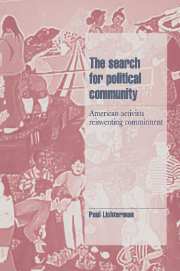Book contents
- Frontmatter
- Contents
- Acknowledgments
- 1 Personalism and political commitment
- 2 Personalized politics: the case of the US Greens
- 3 Speaking out in suburbia
- 4 Imagining community, organizing community
- 5 Culture, class, and life-ways of activism
- 6 Personalized politics and cultural radicalism since the 1960s
- 7 The search for political community
- Appendix I Choosing and studying the organizations
- Appendix II Why participant-observation was necessary
- Notes
- References
- Index
Appendix I - Choosing and studying the organizations
Published online by Cambridge University Press: 23 January 2010
- Frontmatter
- Contents
- Acknowledgments
- 1 Personalism and political commitment
- 2 Personalized politics: the case of the US Greens
- 3 Speaking out in suburbia
- 4 Imagining community, organizing community
- 5 Culture, class, and life-ways of activism
- 6 Personalized politics and cultural radicalism since the 1960s
- 7 The search for political community
- Appendix I Choosing and studying the organizations
- Appendix II Why participant-observation was necessary
- Notes
- References
- Index
Summary
When I began this study in 1989, Time magazine had just placed Earth on its year-end issue's cover as “planet of the year.” Dire reports of a greenhouse effect in the atmosphere cast new doubts on the wisdom of indefinite industrial expansion. As in previous years, most spectators of 1989 Earth Day events would have their consciousness temporarily “raised,” reminding themselves about recycling and growing native plants in their backyards. And a few people would carry on their commitments to participating in movements for environmental change. It has been popular to define action for a common good – the environment in this case – in terms of largely private deeds, like garbage recycling. I was intrigued by those relatively few people who define themselves as publicly engaged activists; this study focuses on them.
CHOOSING THE MOVEMENTS AND THE ORGANIZATIONS
Why environmentalists?
I wanted to find out how personalism has shaped the way people become politicized in the name of a broad public good. Many forms of environmentalism propose broad public goods – clean air and water, safe working conditions, ecologically sound technology – and appeal in theory to all people in a given environment. And communitarian and some radical democracy theorists have noted affinities between personalism and the cultural milieux of the educated middle-class strata. Environmentalist attitudes and environmental activism have been tied to highly schooled middle-class backgrounds as well (Kriesi 1989; Kitschelt 1985; Scaminaci and Dunlap 1986; Cotgrove and Duff 1980; Ladd, Hood, and Van Liere 1980), although prior to this study, there has been little demographic evidence on grassroots environmental activists in the US (see Scaminaci and Dunlap 1986).
- Type
- Chapter
- Information
- The Search for Political CommunityAmerican Activists Reinventing Commitment, pp. 231 - 236Publisher: Cambridge University PressPrint publication year: 1996



